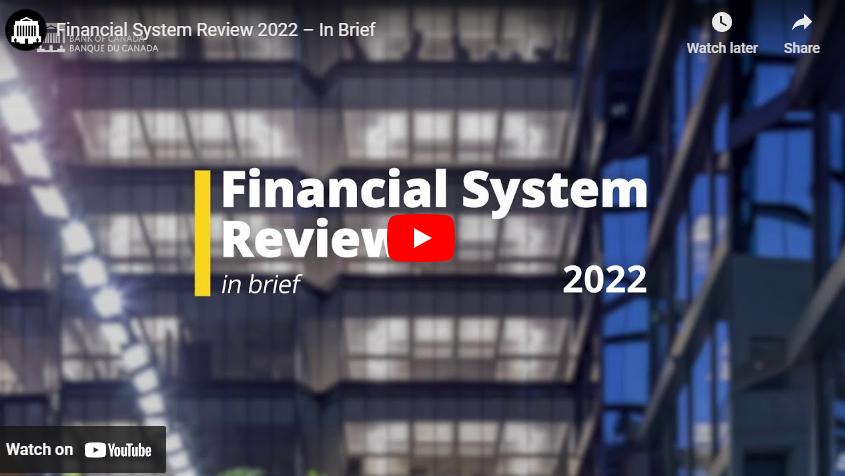
Financial system
The Canadian financial system has remained resilient throughout the COVID‑19 pandemic. This partly reflects the fact that banks relied on sound underwriting practices before the global health crisis and had strong capital and liquidity buffers going into it. Extraordinary policy support during the pandemic, including from the Bank of Canada, was also a key factor.
However, in 2022, financial system vulnerabilities became more complex and risks increased. This is because of new challenges facing the global and Canadian economies, including high inflation, rapidly rising interest rates and slowing growth. Russia’s invasion of Ukraine added to these challenges, intensifying financial market volatility and increasing risks associated with cyber security and the transition to a low-carbon, net-zero economy.
Monitoring vulnerabilities and risks
The Bank’s 2022 Financial System Review presented assessments of key vulnerabilities to the financial system; more detailed analysis is available on the Financial System Hub.
Elevated levels of household debt and high house prices remained two key interconnected vulnerabilities. Throughout the year, Bank staff used microdata to better understand and explain their evolution, notably by:
- assessing the impact of higher interest rates on mortgage payments
- examining mortgage activity by real estate investors
- analyzing the surge in house prices in Canada’s major cities and their suburbs
- publishing a new set of indicators related to these two financial vulnerabilities
Climate change remained an important area of focus for the Bank in 2022 because increases in the frequency and severity of extreme weather events and the transition to a low-carbon net-zero economy pose significant risks to the financial system. The Bank published a report that helped deepen its understanding in this area. This project was an important first step toward gaining a better understanding of the potential exposure of the financial sector to climate transition risks.
The Bank remains actively involved in studying cryptoasset markets and their implications for financial stability. In 2022, Bank researchers published the results of a survey to assess the knowledge and ownership of Bitcoin by Canadians. Also, Bank staff analyzed the benefits and potential risks associated with cryptoassets backed by national currencies, known as stablecoins.
ICYMI: More Canadians are investing in cryptocurrencies, but the growth of these markets has outpaced global efforts to regulate them. They are also vulnerable to large and sudden price declines. http://ow.ly/LQix50JuNVnJun 10, 2022
Analyzing the link between monetary policy and financial stability
Bank researchers explored how unconventional monetary policy interacts with financial stability. Staff analyzed how expansions and contractions in the Bank’s balance sheet impact the banking system. They also developed a model to understand how asset purchases by a central bank can ease pressures on investment dealers during a liquidity crisis.
Monetary policy models with linkages to financial stability provided insight into how raising interest rates could generate financial stress for some borrowers and possibly lead to a further slowing of the economy. Also, staff analyzed how elevated house prices and the decision to buy a house could interact with slowing growth in gross domestic product, especially when homebuyers expect house prices to continue rising.
The Bank paid close attention to how the pandemic affects households differently.1 Notable research analyzed how such diverse experiences could interact with existing financial vulnerabilities, like elevated indebtedness.2 Finally, researchers studied how the range of household financial experiences—particularly regarding the use of mortgage credit—could affect the transmission of monetary policy throughout the economy.
Promoting financial system resilience
Throughout 2022, the Bank worked closely with federal and provincial authorities to monitor, exchange knowledge and promote the resilience of Canada’s financial system.
This included ongoing work with the Heads of Regulatory Agencies and Systemic Risk Surveillance committees.3 Through these federal-provincial forums, the Bank helped improve information sharing and stimulate debate on important financial system issues, including:
- vulnerabilities associated with household indebtedness and the housing market, including the role of investors
- market liquidity issues in fixed-income markets, including open-ended funds4
- risks and gaps in the regulatory perimeter associated with fiat-referenced cryptoassets
- operational risks and the cyber resilience of the financial system
Russia’s invasion of Ukraine increased risks to the cyber security of the financial sector. The Bank and its partners reinforced their cooperation and collaboration on these issues, primarily through the Canadian Financial Sector Resiliency Group.
The Bank also actively participated in discussions within the Financial Institutions Supervisory Committee, notably about the optimal level of capital that banks should maintain through the business cycle. Subsequently, the Office of the Superintendent of Financial Institutions (OSFI) announced changes to the level and range of the domestic stability buffer.5
The Bank worked with its industry partners in the Canadian Fixed-Income Forum to develop a framework for supporting smooth trading and settlement of Government of Canada (GoC) securities in a low interest rate environment. The proposed framework includes a possible fee for failing to settle transactions in GoC securities. A public consultation was launched to solicit feedback on the proposed fee’s structure and governance.6
Check out our latest article for The #Economy, Plain and Simple. It explains how differences among households matter for the economy, the financial system, and monetary policy. http://ow.ly/72SO50JO3sMJul 5, 2022
Contributing to interest rate benchmark reform
The Canadian Dollar Offered Rate (CDOR) will be discontinued after June 28, 2024.7 CDOR has long been a core benchmark in Canada. The end of its publication is a significant milestone in the global migration to risk-free rates, which will help our financial system remain robust and resilient in the decades to come. This is important for Canadian financial markets because over $20 trillion of financial instruments reference CDOR. The cessation of CDOR was based on a recommendation by The Canadian Alternative Reference Rate Working Group (CARR), which the Bank co-chairs.
The end of CDOR will also mean the disappearance of bankers’ acceptances, which account for 20% of Canadian money market products. The Bank facilitated a series of industry workshops to help determine how markets will transition away from bankers’ acceptances.
Overseeing payments and financial market infrastructures
The Bank is responsible for overseeing Canadian financial market infrastructures (FMIs) that have the potential to pose systemic or payment system risks.
In 2022, the Bank conducted the first comprehensive assessment of the cyber practices of designated FMIs, set against expectations released in 2021. The review found that these FMIs generally apply sound business practices when it comes to cyber security.8
Also, the Bank made further progress in implementing the FMI resolution regime by drafting concrete resolution plans for designated FMIs.
Looking forward
In 2023, the Bank will continue to:
- use microdata to enrich its understanding of financial vulnerabilities and provide timely updates to Canadians on how those vulnerabilities are evolving
- incorporate financial stability considerations into monetary policy, including those arising from the heterogeneity of agents
- work closely with domestic and international partners to share information and promote the resilience of Canada’s financial system
- use the results of the public consultation to finalize the proposed framework to support the smooth trading and settlement of Government of Canada securities in a low interest rate environment
- support Canada’s transition away from CDOR and CARR’s work in developing a forward-looking Term Canadian Overnight Repo Rate Average (CORRA) benchmark9
- 1. S. Kozicki, “A world of difference: Households, the pandemic and monetary policy” (remarks delivered virtually to the Federal Reserve Bank of San Francisco Macroeconomics and Monetary Policy Conference, San Francisco, California, March 25, 2022).[←]
- 2. For instance, in the 2022 Financial System Review, the Bank assessed the extent to which households with different levels of indebtedness increased their holdings of liquid assets during the pandemic, which would add to their financial resilience.[←]
- 3. Bank of Canada, “Box 6: Activities of the Heads of Regulatory Agencies Committee and the Systemic Risk Surveillance Committee over the past year,” Financial System Review (June 2022).[←]
- 4. Fragile liquidity in fixed-income markets is an ongoing structural vulnerability. A sudden spike in demand for liquidity from asset managers could exceed the willingness of banks to supply such liquidity, causing large price movements and a potential freeze in some markets. The recent tightening in financial conditions and increased market volatility have reduced liquidity.[←]
- 5. Office of the Superintendent of Financial Institutions, “OSFI sets Domestic Stability Buffer at 3% and adjusts range” (news release, December 8, 2022).[←]
- 6. Bank of Canada, “GMF publishes a consultation paper on a proposed fee for failing to settle GoC securities” (market notice, November 7, 2022).[←]
- 7. Bank of Canada, “CARR welcomes RBSL’s decision to cease the publication of CDOR after June 28, 2024” (market notice, May 16, 2022).[←]
- 8. The Bank will elaborate on the review’s findings in its forthcoming Bank of Canada Oversight Activities for Financial Market Infrastructures 2022 Annual Report.[←]
- 9. The year 2023 will be critical: CARR is targeting the end of the first quarter of 2023 to move all inter-bank activity from CDOR to CORRA. After the end of June, CARR’s transition plan—reflected in OSFI’s supervisory expectations for federally regulated financial institutions—permits no new CDOR exposures (except in loans and the hedging of loans).[←]


